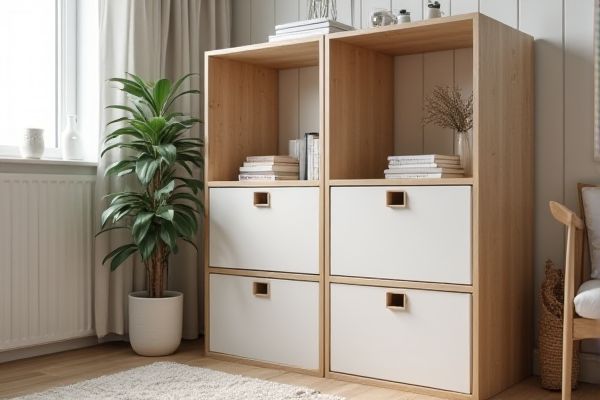
Modular drawers offer customizable storage solutions tailored to fit various spaces, enhancing organization through adjustable compartments, while stackable cubes provide flexible, easy-to-reconfigure units ideal for temporary or evolving storage needs. Discover which option best suits Your home or office by exploring the detailed comparison in the rest of the article.
Table of Comparison
| Feature | Modular Drawers | Stackable Cubes |
|---|---|---|
| Design | Drawer units that fit together seamlessly | Individual cubes stacked vertically or horizontally |
| Customization | Highly customizable with interchangeable drawer sizes | Flexible arrangement with uniform cube sizes |
| Storage Capacity | Optimized for varied item sizes and shapes | Best for evenly sized or bulkier items |
| Assembly | Requires initial setup and alignment | Simple stacking, no tools required |
| Stability | Secure connections prevent movement | Depends on stacking; may need additional support |
| Portability | Individual drawers can be removed for transport | Cubes are easily moved but can be bulky when stacked |
| Ideal Use | Organizing small to medium items with easy access | Quick storage for larger, uniform objects |
| Price Range | Moderate to high, depending on size and materials | Generally affordable and scalable |
Understanding Modular Drawers and Stackable Cubes
Modular drawers offer customizable storage with compartments that slide out for easy access, making them ideal for organizing smaller items efficiently. Stackable cubes provide versatile storage by allowing you to build vertical or horizontal configurations tailored to your space, often used for larger or bulkier items. Understanding the differences helps you choose the right solution based on your storage needs and available space.
Key Features of Modular Drawers
Modular drawers offer customizable storage options with varying drawer sizes and configurations designed to fit specific needs, ensuring efficient organization in any space. Their robust construction often includes smooth-gliding tracks and durable materials, providing ease of access and long-lasting use. You can easily integrate modular drawers into existing systems, enhancing functionality without compromising style or space.
Advantages of Stackable Cubes
Stackable cubes offer versatile storage solutions that maximize vertical space, making them ideal for small rooms or offices. Their lightweight design allows easy rearrangement and customization without tools, adapting to your changing needs. You benefit from enhanced organization and accessibility by creating flexible, multi-level storage configurations.
Space Efficiency Comparison
Modular drawers offer superior space efficiency by maximizing vertical storage within confined spaces, allowing you to customize the layout to fit precise dimensions. Stackable cubes provide flexibility but often result in wasted pockets of air due to uniform cube sizes and less optimized stacking arrangements. Choosing modular drawers enhances organized storage while making the best use of limited room in your home or office.
Customization and Flexibility
Modular drawers offer superior customization with adjustable compartments and sizes tailored to your specific storage needs, enhancing organization efficiency. Stackable cubes provide flexibility by allowing you to rearrange and expand your storage vertically or horizontally, adapting to changing spaces. Your choice depends on whether you prioritize customized internal layouts or versatile spatial configurations.
Aesthetic Appeal and Design Options
Modular drawers offer sleek, customizable aesthetics with various finishes and handle designs, creating a cohesive, modern look tailored to specific spaces. Stackable cubes provide versatile, colorful options that can be arranged in playful or functional patterns, adding a dynamic, organic element to room decor. Both storage types enhance visual appeal but cater to different design preferences--modular units emphasize uniformity and sophistication, while stackable cubes prioritize flexibility and creativity.
Durability and Material Differences
Modular drawers typically feature high-quality materials such as engineered wood or metal frames, offering superior durability and long-term structural integrity compared to stackable cubes made primarily from plastic or fabric composites. The robust construction of modular drawers resists wear, moisture, and deformation, making them ideal for heavy or frequent use, whereas stackable cubes may degrade faster under stress or exposure to environmental factors. Material differences directly impact lifespan and load capacity, positioning modular drawers as a more resilient storage solution for demanding organizational needs.
Cost Analysis: Which is More Affordable?
Modular drawers generally offer a higher initial investment due to their built-in features and customizable options, but their durability and long-term utility often result in better value over time. Stackable cubes tend to be more affordable upfront with simpler designs, making them ideal for budget-conscious consumers seeking flexible storage solutions. Factoring in replacement frequency, modular drawers can prove more cost-effective by reducing the need for frequent upgrades compared to stackable cubes.
Best Uses for Modular Drawers vs Stackable Cubes
Modular drawers are ideal for organizing small office supplies, craft materials, and personal accessories due to their customizable compartments and easy access features. Stackable cubes excel in storing bulkier items like clothing, toys, or books, offering flexible vertical or horizontal stacking options to maximize space. Both solutions provide scalable storage, but modular drawers focus on detailed organization while stackable cubes prioritize capacity and versatility.
Choosing the Right Storage Solution for Your Needs
Modular drawers offer customizable organization with varying drawer sizes and configurations, ideal for maximizing space in offices or craft rooms. Stackable cubes provide flexible, easy-to-rearrange storage that works well for temporary setups and diverse items like toys or books. Assessing your storage goals--permanent organization versus adaptable space-saving options--ensures you select the best solution tailored to your specific needs.
 homyna.com
homyna.com